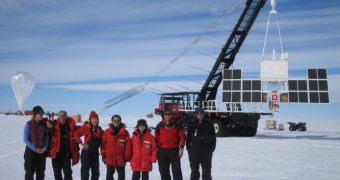For the first time in months, the balloon research program at the American space agency has been resumed, with the launch of a scientific payload destined to study the effects of cosmic rays on our planet.
NASA launched the new instrument in partnership with the US National Science Foundation (NSF), on Monday, December 20. This is the first of five balloons scheduled to take off this December.
The goal of the Cosmic Ray Energetics And Mass (CREAM VI) experiment is to investigate the behavior of high-energy cosmic rays produced by distant supernovae, that reach Earth.
These radiation can have severe effects on life here. They are able to ionize molecules, as in charge them electrically. They do so by stripping off electrons from atoms in those molecules.
When this happens, genetic material such as RNA and DNA can suffer extensive damage. Some experts believe that spikes in cosmic ray radiation levels are responsible for some extinction events.
The CREAM VI experiment, which was designed and built by experts at the University of Maryland, will help scientists gain more insight into how cosmic rays break apart to create particle showers.
At this point, the instrument flies some 126,000 feet above Antarctica, with all of its scientific payloads functioning nominally. NASA provides those interesting with a method of keeping tabs on this mission, by visiting this website.
“Two smaller, hand-launched space science payloads have already been launched, flown, and successfully flight terminated,” NASA experts say in a new press release.
“They carried the Balloon Array for Radiation-belt Relativistic Electron Losses (BARREL) experiment designed and constructed at Dartmouth College,” it reads.
“BARREL will provide answers on how and where Earth's Van Allen radiation belts, which produce the polar aurora, periodically interact with Earth's upper atmosphere,” the document says.
Follow-up experiments to these flights are scheduled for launch in 2013 and 2014. The next instrument to be launched from Antarctica is the Balloon Borne Aperture Submillimeter Telescope (BLAST), which was developed by the University of Pennsylvania.
“This experiment will investigate how magnetic fields impede star formation in our galaxy. BLAST’s instrumentation and telescope will collect data to make the first high-resolution images of magnetically polarized dust in a number of nearby star forming regions,” NASA explains.
NASA’s Wallops Flight Facility in Virginia manages the scientific balloon program for the agency's Science Mission Directorate in Washington, DC. Under NASA safety supervision, the launch operations are conducted by the Columbia Scientific Balloon Facility in Palestine, Texas.
The site is managed by the Physical Science Laboratory of New Mexico State University. The NSF manages the US Antarctic Program and provides logistic support for all US scientific operations in Antarctica.

 14 DAY TRIAL //
14 DAY TRIAL //